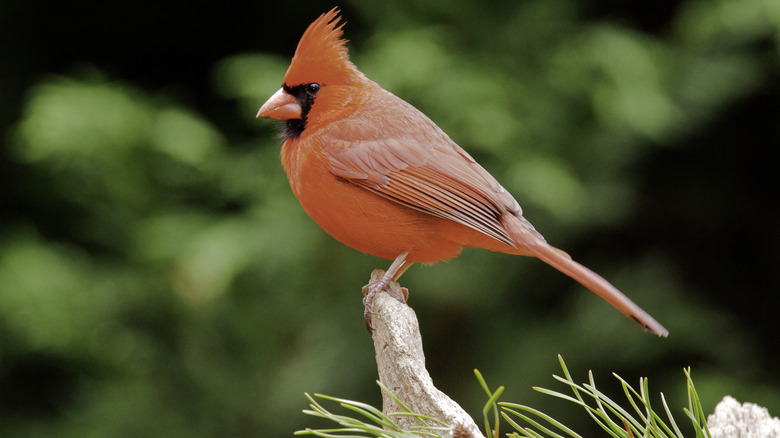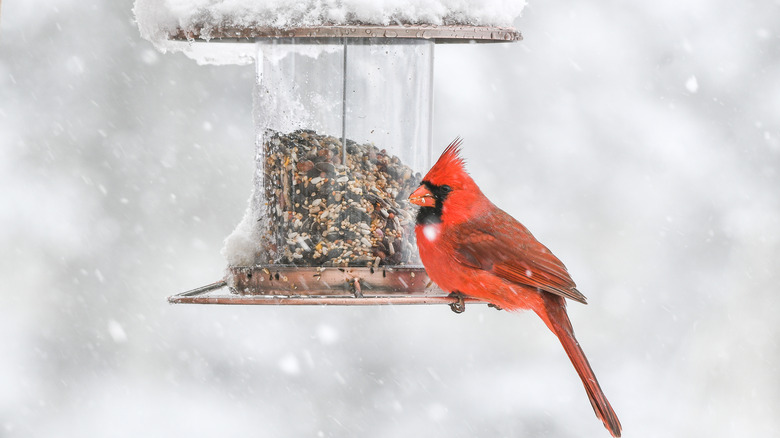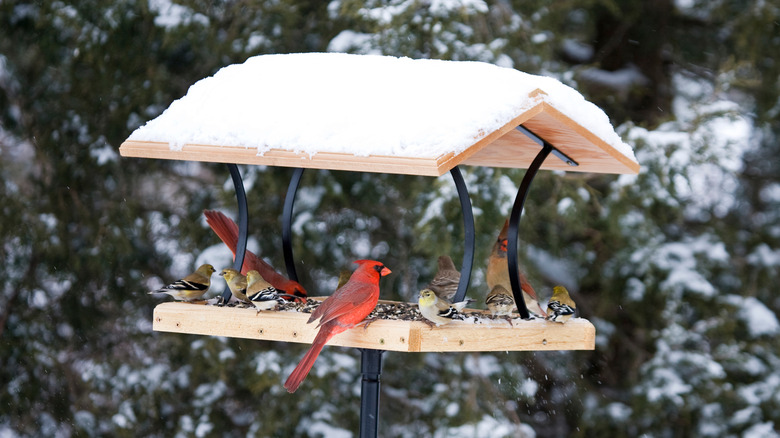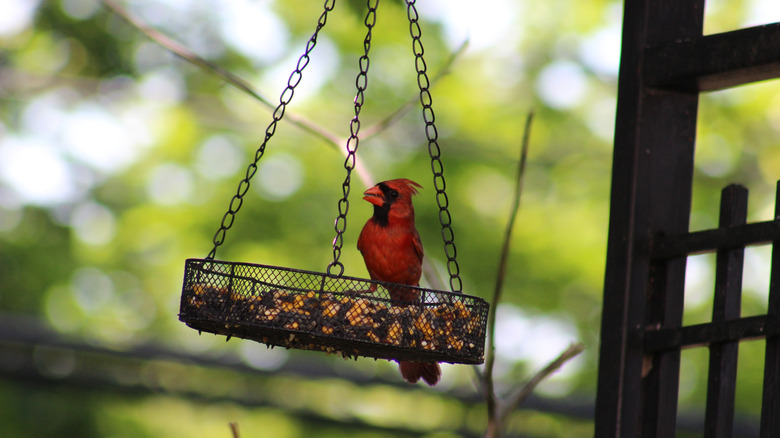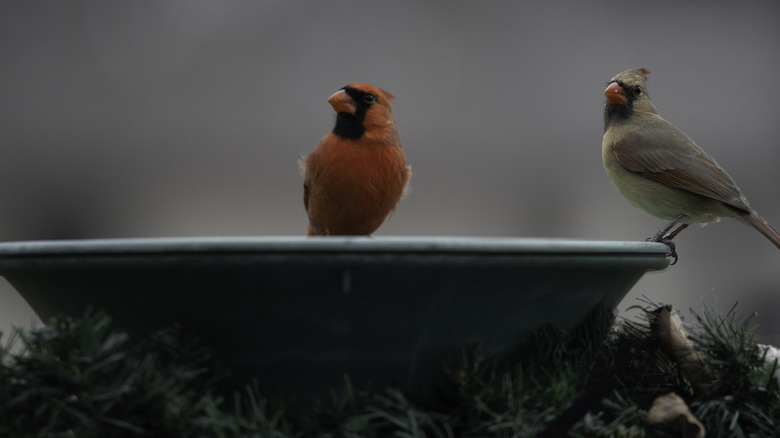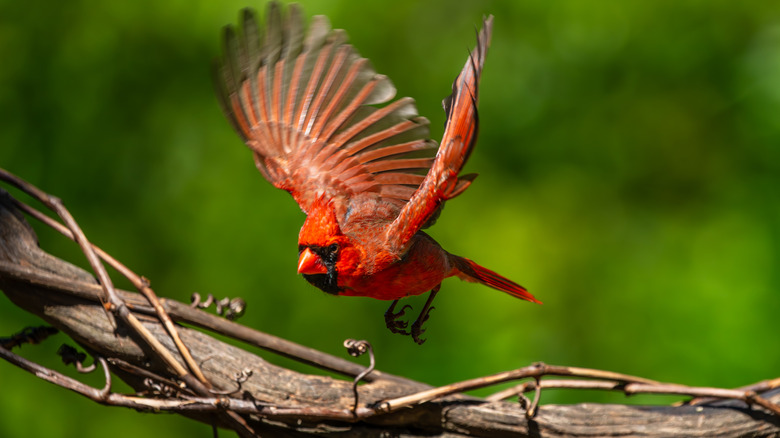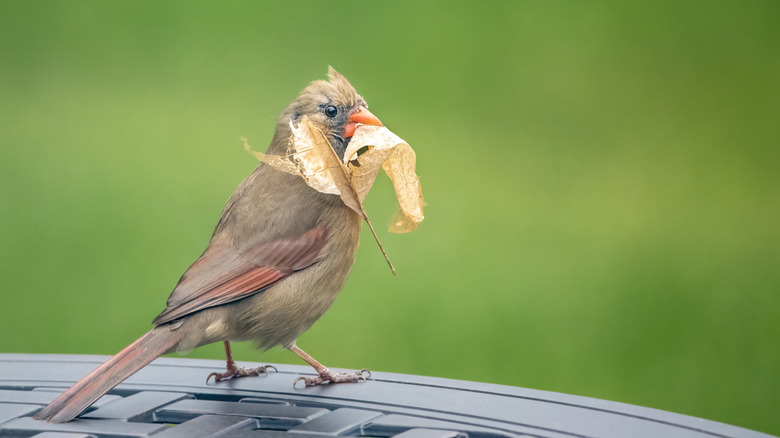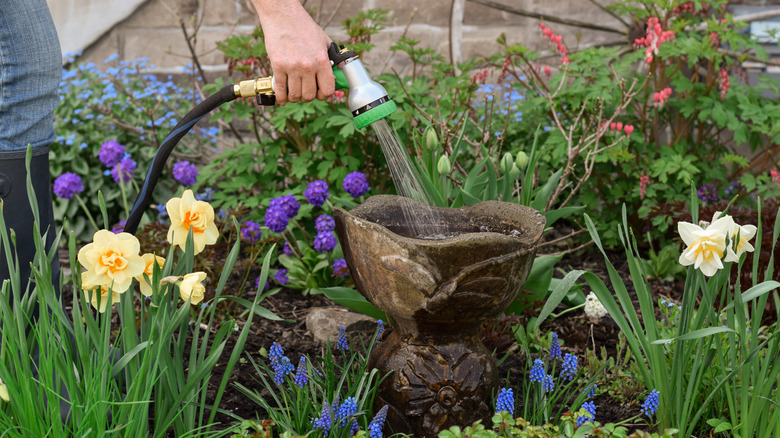9 Mistakes To Avoid If You're Trying To Attract More Cardinals To Your Yard
We may receive a commission on purchases made from links.
Cardinals are a favorite bird of many, even if you don't root for the professional baseball team that shares their name. The male's bright red plumage pops against backyard greenery, and their songs add a touch of cheerful music as they call to one another from the treetops. If you've noticed fewer red feathers flying through your yard, some simple tweaks could encourage their return. While it may seem like you're doing everything right — providing food, water, and shelter — attracting cardinals to your garden takes a bit more strategy.
Luckily, encouraging cardinals to visit your yard isn't as complicated as you may think. If you've noticed a decrease in cardinal activity, a simple tweak, like swapping to their favorite bird seed, may be all that's needed to catch their attention. Once you have a better understanding of these pretty songbirds, it'll be easy to transform your garden into a cardinal haven. But first, make sure you're looking outside at the right times for your best chance at spotting them. Although cardinals are active throughout the day, they tend to show themselves more at dawn and dusk. During their mating season in spring and summer, you'll see them traveling in pairs and hear even more of their melodies. Cardinals flock together in winter, so it's possible to see dozens of visitors during this time if your yard is fully stocked. However, there are a few mistakes you'll want to avoid if you want to see more cardinals all year long.
Filling feeders with the wrong bird seed
Just as we don't all like the same foods, each species has its own preferences. Knowing which type of bird seed to choose to attract your favorites will not only encourage cardinals and other desirable birds to stop by, but it can also help deter the ones you don't want. For example, white proso millet is popular because it's inexpensive and attracts a variety of birds, but it's also a favorite of aggressive species. Bully birds, like house sparrows or brown-headed cowbirds, may take over the feeders and push cardinals out, causing them to choose a calmer place to eat instead.
Focus on filling your feeders with cardinal favorites that will make them want to stop by, but won't be enticing to other species. Larger types of striped sunflower seeds are especially attractive to cardinals, but are harder to open for some unwanted birds like red-winged blackbirds and European starlings. Safflower seed is another tasty choice for redbirds that isn't as palatable to the bullies. If you opt for a mixed seed, it can pay to choose a high-quality brand and avoid blends with filler foods. The birds will pick out the extra stuff they don't want and may search for an area where they can get reliable, high-quality food (like someone else's bird feeder). Stock your feeders with their favorites, and you may see dozens of cardinals flock to your yard for a bite to eat.
Installing the wrong feeders
Cardinals are medium-sized birds, making them larger than many of the common songbirds who may visit your yard. Bird feeders aren't one-size-fits-all, and there are several different designs built with specific species in mind. For example, smaller tube feeders are like magnets for finches, chickadees, and other lightweight species, but their perches and feeding ports are often too small for larger birds like cardinals. If a redbird lands on your feeder and struggles to reach the food or the platform abruptly tips under its weight, it may leave and search elsewhere.
There are several types of bird feeders for cardinals that make it easy for them to access the seed. Hopper feeders are one of the best options, not just for larger birds, but the humans responsible for cleaning and filling them. Because gravity pulls a small amount of food to the bottom at a time, it can store a lot of seed at once, allowing you to refill it less often. Cardinals also love them because the large surface area makes it easy for them to land, perch, and feed comfortably. Additionally, the seed storage protects the food from the elements, keeping it fresh for longer. Platform feeders are also an option, as they have a bigger tray for cardinals to hop around and pick up seeds. The only downside to these bird feeders is that the food is more exposed to rain and air, making it harder to keep clean.
Placing feeders in the wrong area
Once you're stocked up on the cardinal's favorite bird seed and have the right feeder, you'll want to make sure you install it in the right area. In the wild, cardinals find most of their seed in low bushes or foraging on the ground. They prefer feeders that mimic their natural feeding habits, and placing food too high could discourage cardinals from using them. As for table feeders, cardinals can also feel vulnerable to predators, and they prefer to feed in locations that make them feel safe and secure. They'll be reluctant to visit feeders set in open areas without quick escape routes.
Install your bird feeders at table height and about 12 feet from a (preferably evergreen) tree or shrub. This distance gives them the opportunity to quickly retreat if they encounter a threat, but is still far enough away that a predator can't hide and quickly attack. Although you'll want to keep feeders where you can easily watch them, collisions may occur if they're set in the wrong spot. Generally, a distance between 3 and 30 feet is considered a collision zone. Keeping them within 3 feet of your windows helps prevent fatalities, because cardinals won't be able to accelerate quickly enough to harm themselves. Alternatively, installing feeding stations at least 30 feet away gives them enough time to adjust their flight path. Therefore, situate the feeder closer or farther than that danger zone.
Using birdhouses to encourage nesting
The key to filling your yard with feathered friends is providing them with areas to eat, bathe, and nest, so it seems logical to make a charming birdhouse or two. However, these structures are designed for cavity nesters, and cardinals prefer small trees and shrubs to raise their young. Rather than searching for an enclosed space, females look for dense shrubbery to keep their nests hidden from predators. Once she finds a few sturdy branches, she'll get to work using small twigs, grass, and other materials to build a cup-shaped nest that will cradle her eggs.
Although birdhouses won't support a cardinal's nesting habits, there are still steps you can take to encourage a momma bird to nest in your backyard. Plant dense shrubs and trees like dogwood, pine, elm, spruce, hawthorn, or rose bushes where she can find the perfect place to begin construction. If you're able to, adding a few different species at varying heights to create a secure environment, can also encourage cardinals to nest in your yard. Cardinals typically mate in spring and summer, though they may have several broods throughout the year. Look carefully for active nests before pruning and, if possible, avoid cutting branches altogether during nesting season. If you see a red-feathered pair repeatedly flying to the same section of a tree or shrub, there's a good chance hatchlings are nearby.
Having too many reflective decorations
A garden may be a collection of plants to some, but for many, creating an inviting outdoor space is a way to express creativity through design and decor. Although cardinals will be indifferent to most decorations, a few may make them feel on edge when visiting your yard. Cardinals aren't just fiery red in color, they've got the attitude to match. Both males and females are fiercely territorial and commonly perceive other cardinals as threats, especially during nesting season. Reflective objects can trick them into thinking there are other birds around, causing them to attack the reflection. These attacks could lead to injury, but at the very least, will cause unnecessary stress and might make them seek out a less threatening territory.
Avoid using decorations that have reflections, as they can act as a deterrent for cardinals. If you've noticed aggressive behavior, take a moment to explore your backyard through their eyes to see if there is anything that could be setting them off. Windows are also a common issue for cardinals, especially those with mirrored privacy films. If you have a one-way mirror adhesion over your windows, swap it for a one-way transparent film that lets you continue birdwatching, but appears opaque to birds. Alternatively, you can space small, semi-transparent glass decals a few inches apart to make the window more visible and help prevent possible collisions. Installing mosquito screens is another option that reduces the reflection, while allowing you to see outside.
Not accommodating cardinals year-round
As spring approaches, many homeowners excitedly set up whimsical feeders, decorative birdbaths, and anything else to make their yard a bird-friendly paradise. With many birds flying south for the winter, it's easy to forget our favorite non-migrating birds: cardinals. Because they stay in the same area all year, they'll need food, water, and shelter, even when temperatures drop. Food becomes more scarce and natural water sources may be frozen over, so backyard support not only allows you to see more cardinals, but also helps them thrive in winter. One 2008 study published in the Royal Society Publishing journal Biology Letters showed that birds receiving supplemental food during winter had higher fledgling success, suggesting that feeding cardinals positively impacts them in several ways.
Making your yard a reliable spot where cardinals can find food, water, and feel secure year-round will improve your chances of seeing more red feathered friends flit across your lawn. Water is crucial for their survival, so make sure they have a fresh, clean water source they can turn to when the ponds and streams turn to ice. A heated birdbath, such as API's Heated Birdbath, keeps the water warm when temperatures drop, so they can bathe and hydrate all year. Keep their feeders clean and stocked so they can regularly stop by and fuel up during months when they expend extra calories to stay warm. If you can, consider planting evergreens so they'll have a safe place to retreat to.
Not providing shelter from predators
Cardinals want to feel safe and secure in their surroundings and may avoid yards where they feel at risk, especially if they're raising hatchlings. As ground foragers and low nesters, they spend a lot of time in vulnerable areas where predators can easily reach them. Without a quick place to escape to, outdoor cats, raccoons, snakes, and other common predators can more easily attack. Even if they're searching your yard for food, they may hesitate to stay long if they don't spot any safe hiding spots nearby.
Although you can't completely stop unwanted animals from coming onto your property, taking precautions can help protect cardinals and encourage them to stay. Cats are one of the biggest predators of wild birds, and their attacks are even believed to have led to the extinction of some species. To keep cardinals safe, keep pet cats indoors, especially during nesting season. When fledglings leave the nest, they may stay on the ground for a few days before they learn to fly, making them especially vulnerable. To keep snakes from slithering around in your yard and ambushing nests, clean up any fallen bird seed to prevent snakes' other prey, rodents, from stopping by. It's also useful to cut the grass short, which not only helps to prevent snakes, but also makes them more visible. Discourage small mammals from sticking around by keeping your yard clean of any food, securing trash can lids, and installing deterrents, like a squirrel baffle.
Limiting nesting materials
You may have a wide selection of nest-building shrubs and trees lining your backyard, but without the right supplies, cardinals may fly the other way. These methodical creatures plan one to two weeks in advance, scouting different locations to determine the best nesting site. During their search, the male and female cardinals typically start by collecting nesting materials and holding them in their beaks as they test potential areas. So, by having everything they need to build their nests in one area, your yard is more likely to be the most favorable option.
Luckily, the best nesting materials to leave out for birds are likely already in your yard. The female cardinal builds the nest's outer layer with twigs, crushing them with her beak before shaping and securing them in place with her feet. She continues layering the nest with other natural materials like leaves, bark strips, weeds, rootlets, or pine needles, then tops it off with fine grasses or fuzzy fibers to cradle the eggs. Rather than tossing out dried leaves, twigs, cut grass, pine needles, and other potential nest-building supplies when you're doing yard work, gather them all into a small pile for cardinals to easily access. If you have pets, you can add their fur to a suet feeder, allowing cardinals to easily grab pieces as needed for the inner lining. However, make sure the pet hair is clean and free of chemicals like flea and tick repellants or shampoo.
Failing to maintain birdfeeders or birdbaths
Installing birdbaths and feeders in your garden is the first step to attracting more cardinals, but only if you're willing to keep up with maintenance. The more feathered visitors you have, the more droppings and fallen feathers there will be contaminating these areas. Birds are more drawn to clean water and fresh food, so cardinals may hesitate to continue their visits if they show up to find moldy seeds and a murky bath. Even worse, neglected bird baths and feeders can spread diseases, so keeping everything clean helps keep them healthy. On the other hand, cardinals will notice a yard that provides reliable food and water, so empty feeders and baths may encourage them to look elsewhere for food and water.
Make sure to top off feeders and birdbaths as they run low so cardinals have access to bird seed and fresh water throughout the day. If the birds don't eat everything within a few days, or you notice wet chunks of food, toss it out and fill it with fresh seed. Give your feeders a good scrubbing at least every two weeks, but more often if there's a lot of activity. Consider adding a water-moving device to your birdbath to make it less stagnant, which not only makes a rippling sound that attracts cardinals, but also prevents mosquitos from laying eggs. Empty and replace the water every day or two and give it a deep clean at least once each week.
